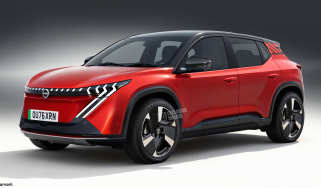Renaultsport Clio 200 EDC Lux
The Renaultsport Clio has grown up, with a new hi-tech approach
It's been a long time since a hot Clio has finished third in a group test. But while the performance is strong, the latest car’s dual-clutch gearbox and inert chassis take away driver engagement. Plus, it’s a little too expensive.
The outgoing Renaultsport Clio was the default choice of the hot hatch purist. The focused driving experience and racy looks meant it stood head and shoulders above its rivals. So while all the cars in this test have been eagerly awaited, arguably it’s the Renault that comes with the greatest weight of expectation.
However, you only have to look at the spec sheet to see that it’s a very different car to its predecessor. The old rev-hungry 2.0-litre engine is gone, replaced by a 1.6-litre turbo that develops exactly the same 197bhp, but with torque that climbs 25Nm to 240Nm.
The most dramatic change, though, is that the newcomer is only available with a six-speed EDC dual-clutch gearbox – there’s no manual.
Renault is also hoping a more subtle look will win people over. While the F1-inspired blade in the front bumper, wider side sills, rear diffuser and twin exhausts add some spice, the newcomer isn’t as overtly sporty as the last car. For starters, there’s no three-door version of the latest Clio, so the Renaultsport now has five doors for the first time.
Used - available now

2018 Nissan
Qashqai
29,208 milesManualPetrol1.3L
Cash £13,997
2023 MINI
Cooper Electric
14,054 milesAutomaticElectric
Cash £13,197
2021 MINI
Cooper Electric
46,402 milesAutomaticElectric
Cash £10,000
2022 Kia
e-Niro
30,353 milesAutomaticElectric
Cash £17,206Our Lux trim test car benefited from the £650 Cup chassis upgrade, which lowers the ride height by 3mm, adds 15 per cent stiffer springs and dampers and 18-inch gloss black wheels, while the £1,300 Liquid Yellow paint brings a much-needed dose of kerb appeal.
Inside, however, things are very different. In line with the standard Clio, the large gloss black centre stack and chrome-surrounded dials aim to give the cabin a smart air, while orange flashes in the trim and seats ensure the RS’s sporty roots are never far away.
Lux-spec cars also get Renault’s R-Link multimedia system, with navigation, Bluetooth and smartphone app functionality – although we found its complexity made simple tasks like tuning the radio frustrating. Worse still, despite the attempted move upmarket, there are too many flimsy fixings and disappointing plastics.
On the plus side, the seats are supportive and comfortable. With a greater range of steering wheel movement than in the old car, the driving position is better, and overall practicality is helped by the 300-litre boot.
The six-speed dual-clutch gearbox also adds to the car’s everyday usability, making the RS no more demanding to drive than a normal Clio. But you can shift gears yourself with either the gear selector or the aluminium paddles that are mounted on the steering column. Using the silver RS switch between the front seats, you can also activate three driving modes – Normal, Sport and Race.
Race deactivates the traction control and limits the gearbox to fully manual operation, complete with 150 millisecond-faster shifts. There’s even a launch control function, which at the test track helped the Renaultsport to out-sprint its rivals and go from 0-60mph in 6.7 seconds.
However, away from a drag race, there’s a bit too much of a delay between pulling the paddle and the next cog engaging. There’s also a big drop-off in revs as the next gear engages, and overall the experience lacks the engagement of its manual rivals.
But it’s the handling that will disappoint enthusiasts. While there’s lots of grip and good body control, the steering is short on feel and, despite being 36kg lighter than before, the 1,204kg Clio is the heaviest car here.
As a result, it feels nose-heavy in corners and the front end washes wide earlier on the track. And despite the RS diff, which mimics the effect of a limited-slip differential, the Clio torque steers over uneven tarmac and squirms unnervingly under hard braking.
Two-stage dampers deliver a more forgiving ride, but as welcome as this extra comfort is, the newcomer sorely misses some of the old car’s sense of agility and fun – especially as the Ford offers these by the bucketload. And with the Fiesta ST-2 weighing in at £17,995, the £18,995 entry-level Clio is left looking expensive in this company, which could really hold it back.






